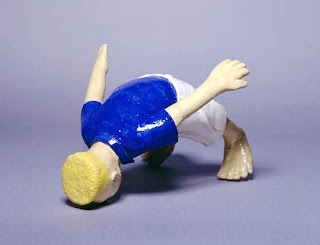I usually follow Yoga asanas in this blog, but today (the beginning of summer) I thought it was time to mix things up and share my other passion: Pilates.
I stumbled upon Pilates after moving to Portland this past September. As a dedicated yogi for years, I had the mistaken understanding that Pilates and Yoga were enemies. So, I faithfully stuck with Yoga. Finding and training for Pilates under my teacher, Leslie Hamm, turned my world upside down. In case you had the same misunderstanding as me, Pilates and Yoga are NOT enemies. In fact, when they're put together, they work beautifully in harmony and help one another. So, the elegant klutz shall now be covering BOTH Pilates and Yoga :)
Not convinced about Pilates yet? There is a reason that Pilates exercises are listed in the top 5 exercises for your abs. Check this chart to compare a gym crunch to a Pilates ab exercise.
Position: Teaser
Type of Pilates: Pilates’
Mat & Pilates’ Reformer
Notice the "C" curve position: rolled off your sits-bones and resting on your sacrum
“How To” While Sitting
on a Pilates’ Mat:
1.
Sit at the top of your Pilates’ mat (different
from a Yoga mat, a Pilates’ mat has much more cushion and is shorter). Inhale
to sit up tall with your shoulders over your hips.
2.
Exhale as you roll of your sits-bones onto your
sacrum. You will find yourself in a “C” curve where you’re rounded in the lower
belly and tall in your sternum and upper chest. Allow your shoulder blades to
drop down your back.
3.
Inhale bring your right knee into tabletop (knee
stacked over your hip), exhale bring your left leg to meet it. If your lower
back or hip flexors start to scream, bring your hands behind your thighs for
support, otherwise reach both arms out by your side. If you’re getting into
your neck, lower your arms. If you feel comfortable in your neck and shoulders,
lift your arms up higher while keeping your shoulder blades dropping down your
back.
4.
Finally, if you feel steady and ready to go to
the next step, exhale and reach your legs long so that your toes point up
towards the sky. Your core stabilizes your legs and arms if you stay static in
this position. To go further, activate your core muscles reaching your legs in
closer towards your body. Keep breathing in through your nose and out through
your mouth. Each time that you activate, reconnect to the core muscles (the
power house in Pilates). Stay for 5-7 breaths or 30 seconds. Repeat 3X.
*Pilates’ Teaser exercise is dynamic and usually moves. In
today’s blog, we are simply holding the Teaser position in an isometric hold as
shown in my picture doing Teaser on a Pilates’ Reformer.
Joseph Pilates, the founder of Pilates, demonstrating the Teaser.
Body Points:
*Keep your legs stick straight if you are ready to reach
them out long
*Drop your shoulder blades down your back
*Whether you keep your legs in tabletop or straight, push
yourself and bring them in closer towards your chest
Emphasized Body
Parts: Rectus Abdominis and External Obliques
Mental Achievements:
Teaser brings a lightness, energy, and uplifting spirit to your body and mind.
An aid for beginners:
For those having trouble bringing both legs up, try the one-legged teaser. Keep
one foot on the floor with your knee bent, bring the other leg into tabletop
and then reach it long up towards the sky. Continue using your breath, deep
inhale through the nose and exhale through the mouth. Do not let your abs go
and stomach expand as you inhale!
Modification: bent knees (less weight on the abs) and hands holding on behind thighs (for hip flexor or lower back issues)
Modifications: Pilates’
exercises do not simply work your Rectus Abdominis (surface abs). They also get
into the deeper abdominal muscles (External Obliques, Internal Obliques, and
Transverse Abdominis) that aid in stabilization and strengthening. If there is
one exercise that you dislike or find really challenging, you can use different
Pilates’ exercises to strengthen the same abdominal muscles. There are also
millions of levels and modifications for Pilates’ exercises. Here are some
modifications for Teaser, but a good rule of thumb is to listen to your body.
It’s important to know the difference between a good hurt (muscle
strengthening) versus a bad hurt (injuring yourself). Similar to Yoga, Pilates
is a somatic technique that encourages a mind/body connection.
Lower back/hip flexor
issues: keep hands behind thighs with shoulder blades cascading down your
back and legs long or bent in tabletop
Spinal Fusion in Lower
Back: Keep legs down, feet on the floor. Roll down into your “C” curve and
lift arms up.
Pain in
Neck/Shoulders: Lower arms to relieve pressure.
Rotator Cuff Injury:
Keep arms down unless you find that lifting to a comfortable height is
appropriate for your body.
*If your lower back, hip flexors, and/or neck begin to hurt
while in Teaser, take a break and then come back into the position. Those areas
are trying to take the weight off of your abs, not strengthening the back, abs,
or hip flexors. So, be safe and know when to come out of the position!
Contraindications: sciatic
pain, osteoporosis (depending on severity)
Sources:
























.jpg)




















